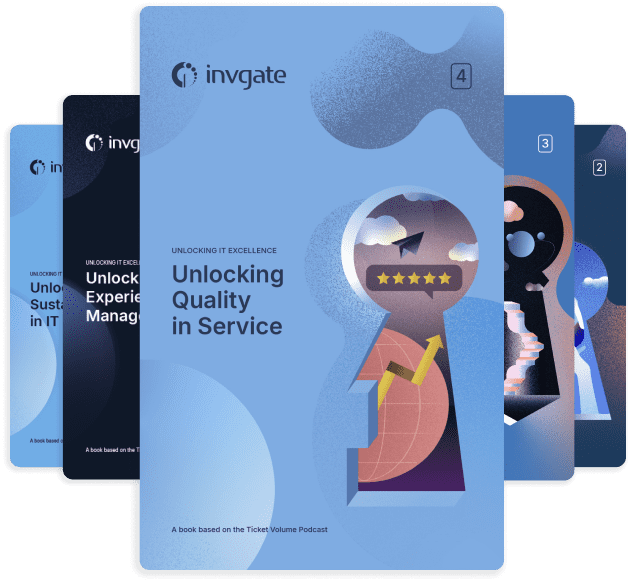There’s a big difference between getting something done and getting it done right, and that difference is what quality is all about. In a field like IT, where technology and expectations are constantly evolving, understanding and measuring service quality is more important than you might think.
It’s more than just ticking boxes; having a good understanding of what quality looks like can help ensure that every service you provide meets the highest standards and truly supports your organization's goals.
In this article, we’ll break down what service quality means within the realm of IT Service Management (ITSM), why it matters, and how you can ensure your IT department isn’t just getting things done, but getting them done right.
Plus, we'll be sharing expert tips straight from our latest Ticket Volume eBook, “Unlocking Quality in Service: Keys to Measuring and Improving Service Management.” You will also find a link below to download the full text!
So if you’re looking to build a more sustainable, efficient, and high-performing IT department, stick around – and don’t miss out on our free eBook that dives even deeper into these topics!
Remember you can subscribe to Ticket Volume and receive all the latest updates of our podcast, new episodes, and more.
Download "Unlocking Quality in Service: Keys to Measuring and Improving Service Management"
Unlocking Quality in Service
Gain invaluable strategies and advanced techniques from industry experts to transform your service management approach.
Download for free
What is service quality in IT?
Service quality in IT is all about making sure that the services provided not only work but work well. It’s about delivering IT services that are reliable, efficient, and truly support what the business needs.
Think of it like this: when a user submits a support ticket or a new software update is rolled out, the goal is for these processes to go smoothly, solve problems, and add real value to the organization.
Quality in IT means paying attention to how well these services align with the broader goals of the business and making sure they consistently meet or exceed the expectations of customers and stakeholders.
Think of it this way: delivering IT services on time is great, but delivering them in a way that aligns with the bigger goals of the business? That’s where the magic happens. Service quality is all about this alignment—ensuring that what IT delivers actually supports what the business is trying to achieve.
For example, it’s one thing to resolve a technical issue quickly, but it’s another to solve it in a way that really helps the customer in the long run. That’s what high-quality service is all about.
And you don’t want to just hit the mark once, but do it consistently, every single time. This means having a solid system in place that supports ongoing improvement, encourages feedback, and creates a culture where quality is a priority in every task, big or small.
In the end, when IT services are delivered with quality at the forefront, they do more than just keep things running smoothly. They help the business grow, adapt, and thrive. High service quality in IT is about making sure that everything works not just today, but in a way that sets the stage for future success.

How does service quality relate to ITSM?
Service quality is what separates the bare minimum from truly great service. ITSM frameworks like ITIL and COBIT are all about making sure IT services do more than just function—they need to work smoothly, efficiently, and in a way that constantly gets better.
When we talk about service quality in ITSM, we’re looking at the key help desk metrics that show how well IT services are really doing. These metrics include things like Key Performance Indicators (KPIs), which track how quickly problems get fixed and how reliable the services are. Service Level Agreements (SLAs) set clear expectations, so everyone knows what "good" service looks like.
But numbers only tell part of the story. Customer feedback metrics, like Net Promoter Score (NPS) and Customer Satisfaction (CSAT), give us real insight into how people feel about the services they’re getting. Are users happy? Would they recommend these services? These details help highlight where things are going well and where there’s room to improve.
Why should IT departments care about service quality?
When IT services run smoothly and consistently meet or exceed expectations, everyone in the organization benefits. High service quality boosts customer satisfaction, which is directly linked to business success. Happy customers are loyal customers, and they’re more likely to stick around and recommend your services to others.
When IT departments focus on quality, they naturally look for ways to improve processes, eliminate waste, and reduce inefficiencies. This can lead to significant resource savings and a lower environmental impact, aligning with broader corporate sustainability goals.
As more companies commit to reducing their carbon footprint, having an IT department that champions high service quality and sustainability can be a real differentiator.
Expert advice on how to ensure service quality
Achieving and maintaining high service quality in IT requires a strategic approach. Here’s some expert advice collected in our latest ebook:
1. Be open to lessons from unexpected places
Kevin Clark, a consultant specializing in ServiceNow and ITSM, underscores the value of drawing lessons from diverse experiences to enhance service quality. In particular, he highlights how skills developed in customer service roles, such as bartending, can be directly applied to IT Service Management.
These experiences teach you to look beyond what people ask for and understand what they truly need, a crucial aspect of delivering quality service.
|
|
"As a bartender, you have a lot of that trying to understand what people are really looking for in their experience, as opposed to what they’ve might asked for or what they’ve might seen on the menu. So, not everything that can you give to someone is necessarily going to be on the menu, as they say." Kevin Clark |
2. Boost service quality by empowering employees
Pasi Nikkanen, Co-Founder of HappySignals, highlights how improvements in employee experience can directly impact service quality. In recent years, IT departments were forced to rapidly adapt their services to meet the evolving needs of employees, leading to significant strides in areas like self-service portals.
These portals, once viewed as a less favorable option, have seen a notable increase in employee satisfaction as companies have learned what it takes to make them successful.
|
|
"We'd realized that the happiness to the self-service portals like the ServiceNow Portal has now started to go up. It was for a long time it was the most hated channel, to be honest, still you just wanted to push it and it was maybe a bit selfish to try to push it there, but now I think we have found the things that you need to do that to make it successful." Pasi Nikkanen |
3. Look beyond traditional metrics
Traditional metrics like CSAT and NPS are valuable, but they often fall short of capturing the full picture of service quality. To truly understand and improve service delivery, it's crucial to incorporate experience-focused metrics like Experience Level Agreements (XLAs).
These metrics go beyond just measuring satisfaction; they tap into the emotional and experiential aspects of service, providing a more comprehensive view.
Joshua Nelson, Director of Technology Experience at Power Design Inc., highlights the importance of not getting too caught up in the terminology of XLAs versus SLAs. He advises focusing on what truly matters:
|
|
"XLA is just another agreement that you have with the company. And yes, it's experience-focused and it's attached more to the emotion side of it rather than the metric. The challenge is that those things existed before we had the term XLA. So now they kind of live in this SLA world, but they probably should be XLAs. That’s why I tell people not to get hung up on it. Measure what matters and you'll be okay." Joshua Nelson |
4. Lean on adaptive learning systems
Adaptive learning systems, powered by machine learning algorithms, are key to enhancing service quality by continuously refining and optimizing service delivery. These systems analyze new data in real time, enabling organizations to quickly adjust strategies based on emerging trends and patterns.
This dynamic approach ensures that improvements are data-driven and consistently aligned with evolving customer needs and market conditions.
Mariena Quintanilla, an expert in data quality testing and support systems, emphasizes the transformative impact of AI-driven tools in Service Management. She notes how these tools significantly reduce the time and effort required for troubleshooting by providing quick, relevant insights based on specific queries:
|
|
"Generative AI, if you don’t use it, you are going to be inferior in the work that you do. There is a need to learn how to leverage it, embrace it. It works in the same way as spreadsheets, that help you do a more effective analysis than if you were plotting things out in pen and paper." Mariena Quintanilla |
5. Integrate customer journey mapping with Unified Service Management
Customer journey mapping is a powerful tool for enhancing service quality, but its effectiveness is multiplied when integrated with a standardized approach like Unified Service Management (USM).
By mapping out the customer's experience and aligning it with standardized practices across departments, organizations can ensure a consistent, high-quality service delivery that meets diverse needs while maintaining coherence.
John Worthington, a seasoned Service Management expert, highlights the importance of a unified approach in managing customer journeys:
|
|
"Both the IT and Finance or other business units are operating at a practice level. They may use different practice frameworks because they have different needs. There's nothing wrong with that, but they have to tree up to something common. There has to be a layer that says, 'Look, this is how the enterprise is going to work.' That's what USM provides." John Worthington |
To conclude
Understanding and measuring quality in IT is essential for building a sustainable and high-performing IT department. By focusing on service quality, aligning metrics with business goals, and fostering a culture of continuous improvement, IT departments can drive customer satisfaction and contribute to overall business success.
Key Takeaways:
- Define service quality: Understand that service quality in IT is about meeting or exceeding expectations, not just delivering services.
- Measure what matters: Align your service quality metrics with broader business goals to ensure that IT services are contributing to the organization’s success.
- Foster continuous improvement: Create a culture that values regular feedback, employee development, and the use of data to make informed decisions.
For more in-depth insights and practical advice on how to improve service quality in your IT department, download our latest ebook, “Unlocking Quality in Service: Keys to Measuring and Improving Service Management,” and subscribe to the Ticket Volume podcast.















